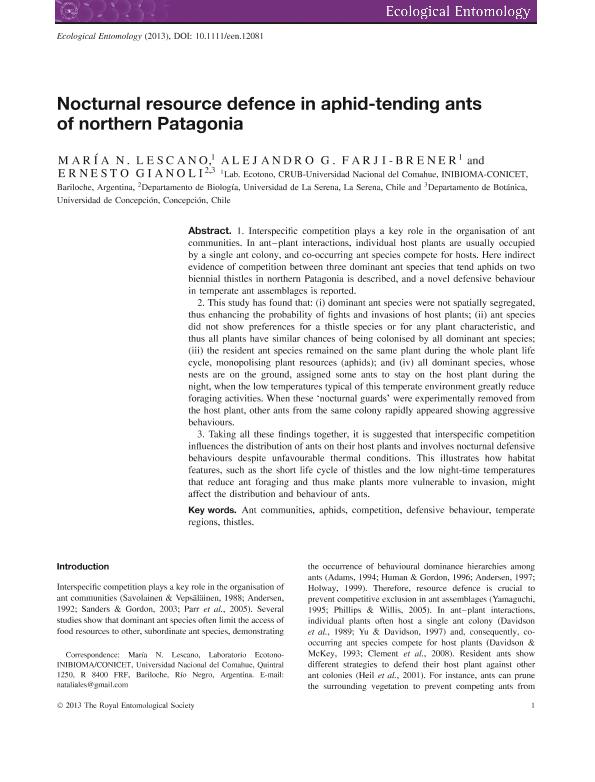Mostrar el registro sencillo del ítem
dc.contributor.author
Farji Brener, Alejandro Gustavo

dc.contributor.author
Lescano, María Natalia

dc.contributor.author
Gianoli, Ernesto
dc.date.available
2016-07-26T19:31:43Z
dc.date.issued
2013-12
dc.identifier.citation
Farji Brener, Alejandro Gustavo; Lescano, María Natalia; Gianoli, Ernesto; Nocturnal resource defence in aphid-tending ants of northern Patagonia; Wiley; Ecological Entomology; 39; 2; 12-2013; 203-209
dc.identifier.issn
0307-6946
dc.identifier.uri
http://hdl.handle.net/11336/6698
dc.description.abstract
Interspecific competition plays a key role in the organisation of ant communities. In ant–plant interactions, individual host plants are usually occupied by a single ant colony, and co-occurring ant species compete for hosts. Here indirect evidence of competition between three dominant ant species that tend aphids on two biennial thistles in northern Patagonia is described, and a novel defensive behaviour in temperate ant assemblages is reported.
This study has found that: (i) dominant ant species were not spatially segregated, thus enhancing the probability of fights and invasions of host plants; (ii) ant species did not show preferences for a thistle species or for any plant characteristic, and thus all plants have similar chances of being colonised by all dominant ant species; (iii) the resident ant species remained on the same plant during the whole plant life cycle, monopolising plant resources (aphids); and (iv) all dominant species, whose nests are on the ground, assigned some ants to stay on the host plant during the night, when the low temperatures typical of this temperate environment greatly reduce foraging activities. When these ‘nocturnal guards’ were experimentally removed from the host plant, other ants from the same colony rapidly appeared showing aggressive behaviours.
Taking all these findings together, it is suggested that interspecific competition influences the distribution of ants on their host plants and involves nocturnal defensive behaviours despite unfavourable thermal conditions. This illustrates how habitat features, such as the short life cycle of thistles and the low night-time temperatures that reduce ant foraging and thus make plants more vulnerable to invasion, might affect the distribution and behaviour of ants.
dc.format
application/pdf
dc.language.iso
eng
dc.publisher
Wiley

dc.rights
info:eu-repo/semantics/openAccess
dc.rights.uri
https://creativecommons.org/licenses/by-nc-sa/2.5/ar/
dc.subject
Ant Communities
dc.subject
Aphids
dc.subject
Competition
dc.subject
Defensive Behaviour
dc.subject
Temperate Regions
dc.subject
Thsitles
dc.subject.classification
Ecología

dc.subject.classification
Ciencias Biológicas

dc.subject.classification
CIENCIAS NATURALES Y EXACTAS

dc.title
Nocturnal resource defence in aphid-tending ants of northern Patagonia
dc.type
info:eu-repo/semantics/article
dc.type
info:ar-repo/semantics/artículo
dc.type
info:eu-repo/semantics/publishedVersion
dc.date.updated
2016-07-22T18:52:37Z
dc.journal.volume
39
dc.journal.number
2
dc.journal.pagination
203-209
dc.journal.pais
Estados Unidos

dc.journal.ciudad
Hoboken
dc.description.fil
Fil: Farji Brener, Alejandro Gustavo. Consejo Nacional de Investigaciones Científicas y Técnicas. Centro Científico Tecnológico Patagonia Norte. Instituto de Investigación en Biodiversidad y Medioambiente; Argentina
dc.description.fil
Fil: Lescano, María Natalia. Consejo Nacional de Investigaciones Científicas y Técnicas. Centro Científico Tecnológico Patagonia Norte. Instituto de Investigación en Biodiversidad y Medioambiente; Argentina
dc.description.fil
Fil: Gianoli, Ernesto. Universidad de la Serena; Chile. Universidad de Concepción; Chile
dc.journal.title
Ecological Entomology

dc.relation.alternativeid
info:eu-repo/semantics/altIdentifier/url/http://onlinelibrary.wiley.com/doi/10.1111/een.12081/abstract
dc.relation.alternativeid
info:eu-repo/semantics/altIdentifier/doi/http://dx.doi.org/10.1111/een.12081
dc.relation.alternativeid
info:eu-repo/semantics/altIdentifier/doi/10.1111/een.12081
Archivos asociados
